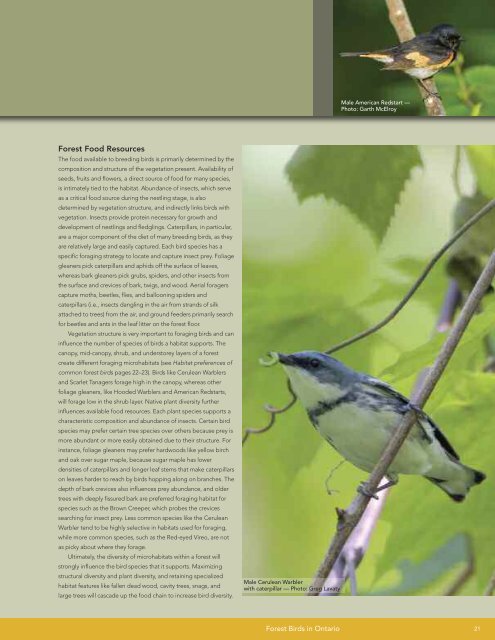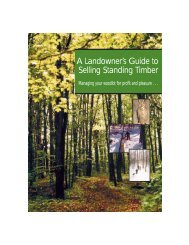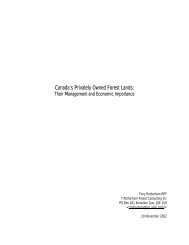A land manager's guide to conserving habitat for forest birds in ...
A land manager's guide to conserving habitat for forest birds in ...
A land manager's guide to conserving habitat for forest birds in ...
You also want an ePaper? Increase the reach of your titles
YUMPU automatically turns print PDFs into web optimized ePapers that Google loves.
Male American Redstart —<br />
Pho<strong>to</strong>: Garth McElroy<br />
Forest Food Resources<br />
The food available <strong>to</strong> breed<strong>in</strong>g <strong>birds</strong> is primarily determ<strong>in</strong>ed by the<br />
composition and structure of the vegetation present. Availability of<br />
seeds, fruits and flowers, a direct source of food <strong>for</strong> many species,<br />
is <strong>in</strong>timately tied <strong>to</strong> the <strong>habitat</strong>. Abundance of <strong>in</strong>sects, which serve<br />
as a critical food source dur<strong>in</strong>g the nestl<strong>in</strong>g stage, is also<br />
determ<strong>in</strong>ed by vegetation structure, and <strong>in</strong>directly l<strong>in</strong>ks <strong>birds</strong> with<br />
vegetation. Insects provide prote<strong>in</strong> necessary <strong>for</strong> growth and<br />
development of nestl<strong>in</strong>gs and fledgl<strong>in</strong>gs. Caterpillars, <strong>in</strong> particular,<br />
are a major component of the diet of many breed<strong>in</strong>g <strong>birds</strong>, as they<br />
are relatively large and easily captured. Each bird species has a<br />
specific <strong>for</strong>ag<strong>in</strong>g strategy <strong>to</strong> locate and capture <strong>in</strong>sect prey. Foliage<br />
gleaners pick caterpillars and aphids off the surface of leaves,<br />
whereas bark gleaners pick grubs, spiders, and other <strong>in</strong>sects from<br />
the surface and crevices of bark, twigs, and wood. Aerial <strong>for</strong>agers<br />
capture moths, beetles, flies, and balloon<strong>in</strong>g spiders and<br />
caterpillars (i.e., <strong>in</strong>sects dangl<strong>in</strong>g <strong>in</strong> the air from strands of silk<br />
attached <strong>to</strong> trees) from the air, and ground feeders primarily search<br />
<strong>for</strong> beetles and ants <strong>in</strong> the leaf litter on the <strong>for</strong>est floor.<br />
Vegetation structure is very important <strong>to</strong> <strong>for</strong>ag<strong>in</strong>g <strong>birds</strong> and can<br />
<strong>in</strong>fluence the number of species of <strong>birds</strong> a <strong>habitat</strong> supports. The<br />
canopy, mid-canopy, shrub, and unders<strong>to</strong>rey layers of a <strong>for</strong>est<br />
create different <strong>for</strong>ag<strong>in</strong>g micro<strong>habitat</strong>s (see Habitat preferences of<br />
common <strong>for</strong>est <strong>birds</strong> pages 22–23). Birds like Cerulean Warblers<br />
and Scarlet Tanagers <strong>for</strong>age high <strong>in</strong> the canopy, whereas other<br />
foliage gleaners, like Hooded Warblers and American Redstarts,<br />
will <strong>for</strong>age low <strong>in</strong> the shrub layer. Native plant diversity further<br />
<strong>in</strong>fluences available food resources. Each plant species supports a<br />
characteristic composition and abundance of <strong>in</strong>sects. Certa<strong>in</strong> bird<br />
species may prefer certa<strong>in</strong> tree species over others because prey is<br />
more abundant or more easily obta<strong>in</strong>ed due <strong>to</strong> their structure. For<br />
<strong>in</strong>stance, foliage gleaners may prefer hardwoods like yellow birch<br />
and oak over sugar maple, because sugar maple has lower<br />
densities of caterpillars and longer leaf stems that make caterpillars<br />
on leaves harder <strong>to</strong> reach by <strong>birds</strong> hopp<strong>in</strong>g along on branches. The<br />
depth of bark crevices also <strong>in</strong>fluences prey abundance, and older<br />
trees with deeply fissured bark are preferred <strong>for</strong>ag<strong>in</strong>g <strong>habitat</strong> <strong>for</strong><br />
species such as the Brown Creeper, which probes the crevices<br />
search<strong>in</strong>g <strong>for</strong> <strong>in</strong>sect prey. Less common species like the Cerulean<br />
Warbler tend <strong>to</strong> be highly selective <strong>in</strong> <strong>habitat</strong>s used <strong>for</strong> <strong>for</strong>ag<strong>in</strong>g,<br />
while more common species, such as the Red-eyed Vireo, are not<br />
as picky about where they <strong>for</strong>age.<br />
Ultimately, the diversity of micro<strong>habitat</strong>s with<strong>in</strong> a <strong>for</strong>est will<br />
strongly <strong>in</strong>fluence the bird species that it supports. Maximiz<strong>in</strong>g<br />
structural diversity and plant diversity, and reta<strong>in</strong><strong>in</strong>g specialized<br />
<strong>habitat</strong> features like fallen dead wood, cavity trees, snags, and<br />
large trees will cascade up the food cha<strong>in</strong> <strong>to</strong> <strong>in</strong>crease bird diversity.<br />
Male Cerulean Warbler<br />
with caterpillar — Pho<strong>to</strong>: Greg Lavaty<br />
Forest Birds <strong>in</strong> Ontario 21

















